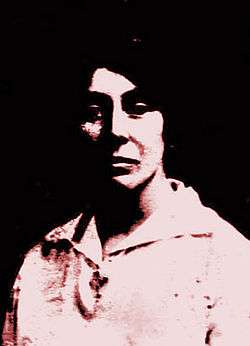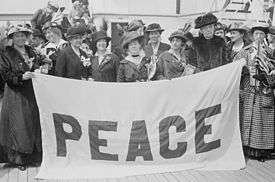Mary Heaton Vorse

Mary Heaton Vorse O'Brien (1874–1966) was an American journalist, labor activist, and novelist. Vorse was outspoken and active in peace and social justice causes, such as women's suffrage, civil rights, pacifism (specifically including opposition to World War I), socialism, child labor, infant mortality, labor disputes, and affordable housing.
Biography
Early life
Mary Heaton was born October 11, 1874, in New York City to Ellen Marvin Heaton and Hiram Heaton.[1] She was raised in prosperity in Amherst, Massachusetts, in a 24-room house with half-siblings from her mother's previous marriage.[2] The money in the family came from her mother's side. In 1852 Vorse's mother married Captain Charles Bernard Marvin, a wealthy shipping magnate and liquor merchant more than 20 years her senior when she was a young woman of 18. Ellen Marvin was widowed at age 37 with five children. In 1873, she married Mary's father, who with his family operated the Stockbridge Inn.[3]
The family traveled widely, spending over a year in Europe, where Mary attended kindergarten in Hanover and the first year of grade school in Dresden, learning the German language in the process.[4] Later, the family had an apartment in Paris, where Mary learned French, followed later by a winter in Austria.[4]
In her 1935 memoir, Mary Heaton Vorse dated her interest in the problems of politics and economics to the years of her youth, when her mother read to her aloud from a book by ethnographer George Kenan,
touching upon the brutal Siberian penal system of Russia.[5] An interest in classic Russian literature followed, complemented by directed reading with her father on topics of American history.[6]
Vorse found her intellect stimulated by life in the college town of Amherst and discussions held in the family home between her father and several prominent friends from academia, including the president of Massachusetts Agricultural College, Henry Hill Goodell, and anthropology professor John Tyler.[7]
Mary Heaton was allowed to leave the formal school system at a young age and subsequently spent several winters in Paris studying art.[4] In 1896, Heaton began to study at the Art Students' League, located on West 57th Street in New York City. The League was established 20 years earlier by strong-minded young men in rebellion from the conservative nature of the instruction at the National Academy of Design. By the time Mary entered, the school was booming, with over 1100 pupils studying in sex-segregated day and evening classes, studying sketch art, sculpture, and painting.[8]
While Mary found participation in the artistic avant-garde exhilarating, she unfortunately was sadly lacking in talent. She wrote in her diary: "When I come into my room and see my work lying around, my sense of my own futility overwhelms me. After so much work, that is all I can do."[9]
Career
Young Mary Heaton was intelligent and athletic and deeply influenced by the ideas of feminism that had begun to emerge as the 19th century came to a close. Many upper-class women such as Mary were in the forefront of the movement for women's rights to economic independence, education, voting rights, and birth control.[10]
Mary Heaton's first husband was Albert White "Bert" Vorse, a widely traveled journalist who had worked for a year in a Boston settlement house run by Edward Everett Hale.[11] The pair were married after a brief courtship in 1898 and had two children, a boy born in 1901 and a girl born in 1907.[12]
The couple began to take an increased interest in social problems of the day, spurred by the muckraking reformist politics of the day and a personal friendship with radical journalist Lincoln Steffens.[11] The Vorses would frequently go sailing with Steffens and his wife on the Vorses' boat, where they would be regaled with Steffens' "epic stories" of "gigantic lootings and skulduggeries."[13]
Bert Vorse was soon assigned to Paris as the correspondent of the Philadelphia Ledger.[13] It was in France that Mary Heaton Vorse, encouraged and instructed by her husband, began to try her own hand at professional writing.[13] Mary began to create and sell romantic fiction to women's magazines. Her stories often featured the motif of a rugged and energetic heroine who managed to win the affection of a coveted male over a more constrained and conventionally feminine rival.[14]
In 1904, Mary and her husband moved to Venice, where Mary was first introduced into the world of the working class and their labor struggles.[15]
Bert Vorse died on June 14, 1910, of a cerebral hemorrhage.[16]
Activism and journalism

In 1912, she married the journalist Joe O'Brien, a socialist from Virginia whom she met at the 1912 Lawrence Textile Strike.[17] The couple had one child, a boy, born in 1914.[18] Joe O'Brien died in 1915.[19]
Vorse was active in the fight against militarism and American entry into World War I and was a founding member of the Woman's Peace Party in January, 1915. She was chosen as the delegate of the New York Woman Suffrage Party to an International Women's Peace Congress held in The Hague at the end of April, 1915, traveling aboard the MS Noordam through mine-strewn waters to attend.[20]
Newspapers and magazines she wrote for included the New York Post, New York World, McCall's, Harper's Weekly, Atlantic Monthly, The Masses, New Masses, New Republic, and McClure's Magazine, as well as various news services.[21]
She participated in and reported on the Lawrence Textile Strike, the steel strike of 1919, the textile workers strike of 1934, and coal strikes in Harlan County, Kentucky.[22]
From 1919 until 1923, Vorse was in a relationship with the radical political cartoonist and Communist Party functionary Robert Minor.[23]
Awards
Four years before her death in 1966, the 88-year-old Mary Heaton Vorse entered the silver jubilee banquet of the United Auto Workers union, accompanied by union leader Walter Reuther. There, she received the first UAW Social Justice Award, with former first lady Eleanor Roosevelt and novelist Upton Sinclair looking on to share her honor.[24] Vorse was feted for her work as one of the most important labor journalists of the 1920s and 1930s.
Death and legacy
Vorse died of a heart attack on June 14, 1966, at her home in Provincetown, Massachusetts, on the extreme tip of Cape Cod, where she was buried.[25] She was 92 years old.
In addition to her memoir written in 1935, Vorse participated in an oral history project at Columbia University in 1957, an interview which has been transcribed and microfilmed by the university.[26]
Vorse also wrote several ghost stories, including "The Second Wife" (1912).[27] [28] These stories were later collected in the Ash-Tree Press volume, Sinister Romance : Collected ghost stories.
Vorse is sometimes remembered anecdotally as the inspiration for the fictional character "Mary French" in John Dos Passos' trilogy USA.[29]
Footnotes
- ↑ Dee Garrison, Mary Heaton Vorse: The Life of an American Insurgent. Philadelphia: Temple University Press, 1989. Page 6.
- ↑ Garrison, Mary Heaton Vorse, pg. 3.
- ↑ Garrison, Mary Heaton Vorse, pp. 5-6.
- 1 2 3 Vorse, A Footnote to Folly, pg 26.
- ↑ Mary Heaton Vorse, A Footnote to Folly: Reminiscences of Mary Heaton Vorse. New York: Farrar and Rinehart, 1935; pg. 22.
- ↑ Vorse, A Footnote to Folly, pp. 22-23.
- ↑ Vorse, A Footnote to Folly, pg 25.
- ↑ Garrison, Mary Heaton Vorse, pg. 22.
- ↑ Garrison, Mary Heaton Vorse, pg. 24.
- ↑ Garrison, Mary Heaton Vorse, pg. 16.
- 1 2 Vorse, A Footnote to Folly, pg 28.
- ↑ Garrison, Mary Heaton Vorse, pp. 25, 29, 38.
- 1 2 3 Vorse, A Footnote to Folly, pg 29.
- ↑ Garrison, Mary Heaton Vorse, pg. 31.
- ↑ Garrison, Mary Heaton Vorse, pp. 32-33.
- ↑ Garrison, Mary Heaton Vorse, pg. 44.
- ↑ Garrison, Mary Heaton Vorse, pp. 56, 60.
- ↑ Garrison, Mary Heaton Vorse, pg. 84.
- ↑ Garrison, Mary Heaton Vorse, pg. 100.
- ↑ Garrison, Mary Heaton Vorse, pg. 88.
- ↑ "Glossary of People:Vo". marxists.org. Retrieved 2007-02-13.
- ↑ "Mary Heaton Vorse". spartacus.schoonet.co.uk. Retrieved 2007-02-13.
- ↑ Garrison, Mary Heaton Vorse, pp. 137, 184.
- ↑ Dee Garrison (ed.), "Introduction" to Rebel Pen: The Writings of Mary Heaton Vorse. New York: Monthly Review Press, 1985. Page 7.
- ↑ Garrison, Mary Heaton Vorse, pp. 325-327.
- ↑ "Reminiscences of Mary Heaton Vorse: Oral History, 1957," Transcription copyright by the Trustees of Columbia University in the City of New York, 1975.
- ↑ Catherine A. Lundie, Restless Spirits : ghost stories by American women, 1872-1926.Amherst:University of Massachusetts Press, 1996. (pp. 15,203)
- ↑ Jeffrey Andrew Weinstock, Scare tactics : supernatural fiction by American women. New York : Fordham University Press, 2008. ISBN 0823229858 (p. 109)
- ↑ Garrison, Mary Heaton Vorse, pg. 185.
Works
- The Breaking In of a Yacthtsman's Wife. Boston: Houghton, Mifflin and Co., 1908. —Fiction.
- The Whole Family. (Contributor.) New York: Harper and Brothers, 1908. —Fiction.
- Autobiography of an Elderly Woman. Boston: Houghton, Mifflin and Co., 1911. —Fiction.
- The Very Little Person. Boston: Houghton Mifflin Co., 1911. —Fiction.
- The Heart's Country. Boston: Houghton Mifflin Co., 1914. —Fiction.
- The Sturdy Oak: A Composite Novel of American Politics by Fourteen American Authors. (Contributor.) New York: Henry Holt, 1917. —Fiction.
- I've Come to Stay: A Love Comedy of Bohemia. New York: The Century Co., 1918. —Fiction.
- The Prestons. New York: Boni and Liveright, 1918. —Fiction.
- Growing Up. New York: Boni and Liveright, 1920. —Fiction.
- Men and Steel. New York: Boni and Liveright, 1920.
- The Ninth Man: A Story. New York: Harper and Brothers, 1920. —Fiction.
- Wreckage: A Play in One Act. With Colin Clements. New York: D. Appleton, 1924.
- Fraycar's Fist. New York: Boni and Liveright, 1924. —Fiction.
- Passaic. New York: International Labor Defense, 1926.
- The Passaic Textile Strike, 1926-1927. Passaic, NJ: General Relief Committee of Textile Strikers, 1927.
- Second Cabin. New York : Horace Liveright, 1928. —Fiction.
- Gastonia. n.c.: n.p., 1929.
- A Footnote to Folly: Reminiscences of Mary Heaton Vorse. New York: Farrar & Rinehart, 1935. —Memoir.
- Labor's New Millions. New York: Modern Age Books, 1938.
- Time and the Town: A Provincetown Chronicle. New York: Dial Press, 1942.
- America's Submerged Class: The Migrants. Cleveland, OH: National Consumers League, n.d. [c. 1953].
- Rebel Pen: The Writings of Mary Heaton Vorse. Dee Garrison, ed. New York: Monthly Review Press, 1985.
- Strike! Urbana: University of Illinois Press, 1991. —Fiction.
External links
- Mary Heaton Vorse Papers at Walter P. Reuther Library of Labor and Urban Affairs.
- Mary Heaton Vorse Internet Archive, Marxists Internet Archive.
- 1919 passport photo ; Mary Heaton Vorse
- Works by Mary Heaton Vorse at Project Gutenberg
- Works by or about Mary Heaton Vorse at Internet Archive
- Works by Mary Heaton Vorse at LibriVox (public domain audiobooks)
